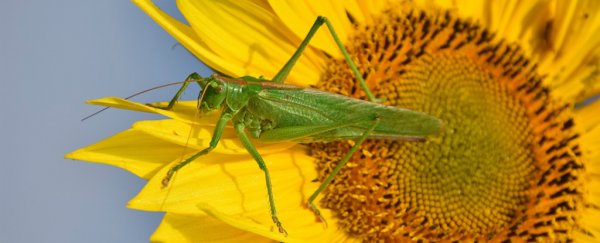Insects like grasshoppers and crickets may play a role in pollination, new research finds.
We tend to think of these critters, called orthopterans, as agricultural pests, but their tropical relatives provide a valuable service to plants by serving as pollinators, according to the study.
"When people think of pollinators, bees and butterflies are usually the first that come to mind. There are very few records of orthopterans that visit flowers, and none of the studies involve Southeast Asian orthopterans," says first author Tan Ming Kai, a PhD student from the biological sciences department at the National University of Singapore Faculty of Science.
Tan and his colleagues conducted surveys in five Southeast Asian countries and discovered that orthopterans visit flowers more frequently than previously known, and they pollinate the flowers they visit.
The Journal of Orthoptera Research published those results in 2017.
"Given that more orthopteran species are being discovered in this region, there is a pressing need to better understand the biological roles they play, particularly when they visit flowering plants, and how they contribute pollination services for urban plants and agricultural crops," adds Tan, who has discovered over 60 species of orthopterans new to science since 2009.
Pollinators or pests?
Pollination is crucial for plant reproduction and supply of food crops for human consumption.
As many Southeast Asian countries rely on agriculture as the main source of economic growth, baseline information on flower-visitors are useful in identifying orthopterans that are potential pests, and those that may potentially be pollinators.
"Without such studies, it is not possible to assess the risks presented by these potential pest species, as well as to further examine the beneficial roles of the flower-visiting orthopterans," explains project supervisor Hugh Tan, an associate professor in the biological sciences department.
To better understand the roles that orthopterans play in pollination ecology, the research team conducted field surveys across different vegetation and localities in Singapore, Malaysia, Thailand, Brunei, Darussalam, and Indonesia between 2015 and 2018.
The study involved both day and night surveys during which the researchers searched for flower-visiting orthopterans and recorded them with photographs and videos.
Watch the bug 'ballet' of jumping spider crickets
The team recorded 140 incidences of orthopterans visiting flowers across the survey sites, among which the researchers recorded 41 orthopteran species visiting flowers of 35 plant species. Out of the 41 species, 19 species were katydids, 13 were grasshoppers, and 9 were crickets.
Gentle feeding
The researchers also discovered two main types of flower-visiting orthopterans—firstly, katydids that are floriphilic, clearly preferring flowers over other plant parts as their diet; and secondly, opportunistic folivores, such as cone-headed katydids (Conocephalus species) and Bukit Timah's cricket (Tremellia timah) which typically consume leaves, but consume flower matter when it's available.
Among flower-visiting orthopterans, adults and nymphs of the sickle-bearing katydid Phaneroptera brevis were frequently found among flowers in Southeast Asia.
To examine how the feeding behaviour of P. brevis contributes to pollination, the research team observed how P. brevis feeds on the flowers of the hairy beggarticks Bidens pilosa L. (Asteraceae), a tropical to warm temperate North and South American plant which grows in grasslands and scrublands close to urban areas in Singapore.
Close observation of the video recordings showed that the sickle-bearing katydid fed on the flowers without damaging the parts of the flowers by gently collecting the pollen grains. Pollen grains attached to the antennae and legs of the katydid facilitated pollination.
3X more likely to produce seeds
The team also conducted experiments in which they exposed the flowers to the katydids, and then allowed them to develop into seeds. Researchers found that the chance of these flowers producing seeds was about three times higher. These results appear in the journal Ecology.
"Our findings suggest that current knowledge of orthopterans as flower-visitors and their role in pollination ecology is still in its infancy," says Tan.
How wings let bugs take over the world
The researchers hope to conduct more studies to better understand how orthopterans can function both as pollinators and harmful plant-eaters, and how these unconventional pollinators co-evolve with plants.
The study took place in collaboration with researchers from the Thailand Institute of Scientific and Technological Research, Universiti Brunei Darussalam, Universiti Sains Malaysia, and University of Malaya.
Source: National University of Singapore
This article was first published on Futurity. Read the original article.
